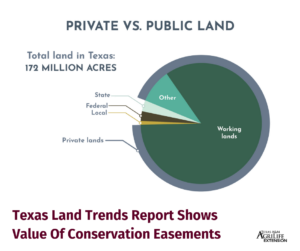February 26, 2019
The Texas Land Trends project of Texas A&M’s Natural Resources Institute, or NRI, has published a special series report describing Texas landowner participation in land conservation easements and their value to agricultural production, water and wildlife.
About 83 percent of lands in Texas are classified as privately-owned working lands, signifying the critical role private landowners play in protecting the state’s valuable resources. Land-use conversion, including fragmentation, accounted for the loss of approximately 1.1 million acres of working lands in Texas between 1997 to 2012.
According to the Texas Land Trust Council, conservation easements have been an effective tool used by land trusts, government agencies and conservation groups to protect approximately one million acres of private land in Texas. It offers a voluntary, alternative to assist private landowners in keeping their lands intact while promoting good stewardship and land management practices.
Dr. Roel Lopez, NRI director, said the institute, in collaboration with the council and Texas Agricultural Land Trust, incorporated several datasets, including those from the Texas Comptroller and U.S. Department of Agriculture’s Census of Agriculture, developed a framework for evaluating the conservation value of lands currently protected under conservation easements. Results of these evaluations can be found online in the Texas Land Trends report “Conservation Easements in Texas.”
Lopez said Texas has approximately 248,000 farm and ranch operations accounting for over 142 million acres of land use.
Lopez said an NRI study concluded conservation easements are six times more efficient than non-land conservation strategies. In Texas, these have the potential to capture over 980,000 acre-feet of water annually, representing a $207 million water replacement cost savings per year.
He said the NRI’s analysis suggests that conservation easements in Texas have the potential to provide approximately $5.8 million in total wildlife value annually.
Lopez said more than 88 percent of conservation easements in the state were executed in the past two decades, indicating an increasing interest and willingness among private landowners to use conservation easements.
Source: AgriLife Today



























